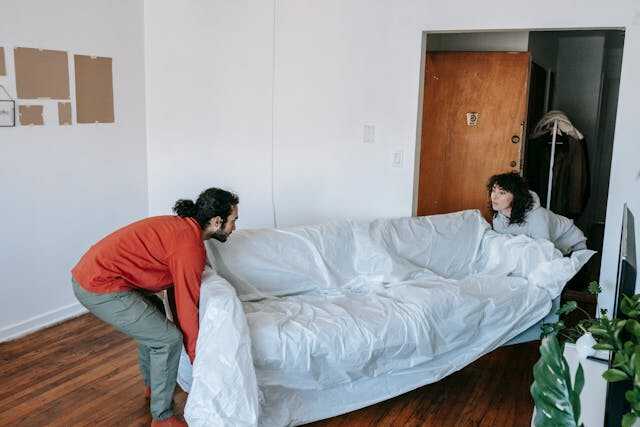Moving into a new house excites and overwhelms at the same time. Every wall, corner, and fixture feels different, and your old couch or table does not always suit the new space. That is why old furniture rarely fits a new home, both in design and function. Readers should think critically, compare options, and engage with fresh ideas. When you take an active role, you shape your environment rather than allowing it to dictate your comfort. And that is the key to successful home decor decisions.

The Illusion of Familiar Comfort
People often cling to furniture because it carries emotional weight. A sofa reminds you of family gatherings. A table may hold traces of past celebrations. These connections feel powerful. Yet nostalgia can cloud clear thinking. A cherished chair may not match the scale or mood of your new interior.
However, attachment to old furniture does not need to vanish. Instead, evaluate what truly adds value and what limits growth. This active assessment helps separate memory from daily needs. With clarity, you gain freedom to create spaces that reflect current priorities.

Spatial Dynamics of a New House
Room proportions rarely remain consistent between houses. A tall ceiling may dwarf your old dining table. A narrow living room might not hold the oversized sectional that once fit. These shifts frustrate many homeowners.
Therefore, before placing each piece, study the layout. Ask yourself if scale, flow, and function align—measure doors, corners, and wall lengths. When you compare those dimensions to your furniture, reality becomes clear. If the fit looks awkward, rethink placement rather than forcing it.
To simplify, keep in mind these quick checks:
- Does the piece overwhelm or underwhelm the room?
- Can people move easily without tripping or squeezing?
- Does the furniture highlight or hide natural light sources?
Through careful review, you avoid clutter and maintain balance. Remember that old furniture rarely fits a new home when proportions fail to align.
Old Furniture Rarely Fits a New Home Because of Style Shifts Between Homes
Architectural differences create another challenge. A rustic oak cabinet can look misplaced in a sleek condo. A glass coffee table may feel wrong inside a classic colonial house. Style conflicts distract the eye and reduce comfort.
Thus, match design language to your home’s features. If walls and finishes lean modern, try clean lines. If beams and trim evoke tradition, introduce warm woods. Mixing styles can work in moderation, but extremes often clash. Active editing ensures harmony.
Modern Needs vs. Outdated Pieces
Life changes demand fresh solutions. Work-from-home setups, family growth, or entertaining needs shape how you use space. A stiff mattress or bulky headboard no longer suits evolving expectations. Here, new choices prove practical.
For example, the market now offers contemporary beds with hidden storage, sleek frames, and ergonomic designs. They match compact apartments as well as larger suburban houses. Outdated frames not only waste space but also miss comfort upgrades. By adjusting, you respect your current lifestyle and health.
The Hidden Costs of Holding On
Heavy items often require special moving crews, extra trucks, or costly repairs when walls get scratched. These expenses add up fast. Sometimes, the price to relocate old furniture exceeds its actual value.
Also, consider the effort of cleaning, repairing, or maintaining pieces that do not truly belong. Energy spent on misfits steals attention from creating a fresh home atmosphere. By weighing true costs, you see that clinging to the past can drain both wallet and spirit.

Sustainability and Letting Go
Every home move offers a chance to clear clutter. By choosing to donate or recycle, you cut waste and help others in need. Many charities welcome quality furniture and resell it to fund community programs.
Thus, when you get rid of old pieces, you make space for renewal. This step reduces landfill pressure and opens room for furniture that better suits your lifestyle. Active decisions in this stage lead to lighter, healthier homes.
Blend Old with New
Some furniture still deserves a place. An antique sideboard can balance a sleek dining room. A grandfather clock may anchor a modern hall with elegance. These items create character when used sparingly.
Yet, restraint is vital. Too many dated items confuse and disrupt the flow. Consider one or two focal heirlooms while embracing clean lines elsewhere. This mix respects memory and reflects current taste. By editing with purpose, you gain control of design harmony.
Technology and Functionality in Furniture
Furniture no longer serves only aesthetic roles. Desks now integrate power ports. Sofas often include USB outlets. Tables may hide modular storage. These features shape how rooms support daily activity.
Because of this, older furniture sometimes fails practical tests. A heavy oak desk looks noble yet blocks the use of laptops and charging tools. A classic bed frame lacks under-storage, which maximizes compact rooms. When homes demand smart solutions, tradition struggles to keep pace.
Therefore, remember that old furniture rarely fits a new home, not only in style but also in function. Ignoring this fact restricts comfort and reduces convenience. Active homeowners adapt instead of resisting.
Follow the Flow of Style
Design does not stand still. Each year, new colors, textures, and layouts inspire homeowners. Following decor trends 2025 helps ensure spaces feel fresh rather than dated. Think neutral palettes with bold accents, streamlined profiles, and eco-friendly materials.
Trends should not dictate every purchase, but they guide choices. By aligning with broad shifts, you create rooms that welcome guests and soothe the family. Ignoring them risks clinging to a look that feels outdated before long. Balance matters, but awareness provides a clear edge.
Emotional Renewal in a Fresh Environment
Moving allows a reset. New walls invite new habits. Old patterns fade while new ones grow. Furniture becomes a tool in this transformation. When each item matches your current phase, you gain confidence.
Holding on to the wrong couch or dresser drags the past forward. Choosing supportive pieces signals progress and encourages optimism. Readers must act decisively here, not wait passively for change to happen. By curating with purpose, you design a home that uplifts rather than confines.

Build the Home That Works for You
In the end, old furniture rarely fits a new home because both people and spaces evolve. Sentiment matters, yet function, style, and comfort matter more. Readers who evaluate with courage will discover freedom. Use each move as an active chance to refresh, select wisely, and embrace today. Through conscious choice, your house reflects who you are now, not who you were before.
